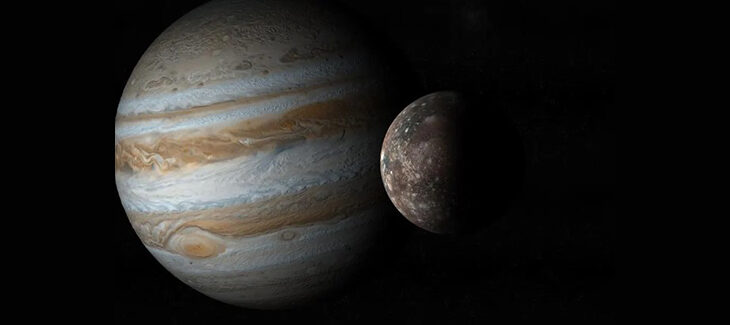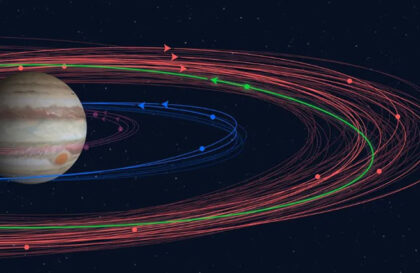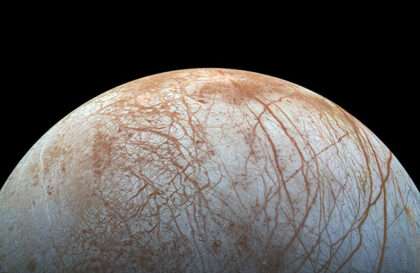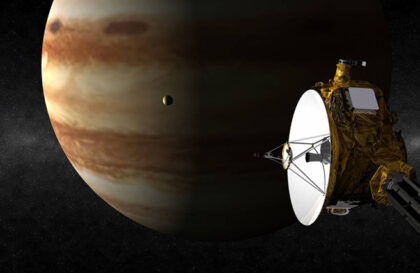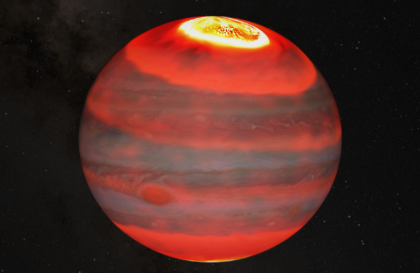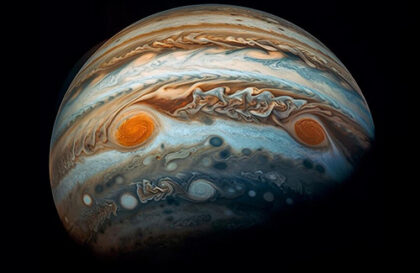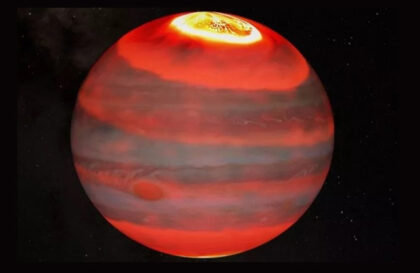The most giant crater in the solar system is located here on Calisto. This is Valhalla, with a diameter of 1900 miles (2600 kilometers). Calisto is the most cratered body in the Solar System. It is 4.5 billion years old. Its surface was formed 4 billion years ago.
Callisto, a satellite of Jupiter, impresses with its mystery and uniqueness. With a diameter of 4,800 km, it differs from its moons Io, Europa, and Ganymede in that almost all of its surface relief is pockmarked with craters, evidence of possible collisions with celestial bodies. Unlike them, Callisto does not indicate its own volcanism or tectonic activity. Its craters have a weakly defined shaft and shallow depth, and surface temperatures at the equator can reach 150° K. The surface is estimated to be about 3.5-4 billion years old, and despite this long existence, there are no further traces of extensive plains or furrows.
Credit: NASA/ Science On a Sphere/ Dataset Developer Bjorn Jonsson
According to a computer model presented in 2018, Callisto and other Galilean moons may have formed with the participation of Saturn. As Saturn’s core increased, its gravitational pull could carry planetesimals, or young planets, into the inner solar system. This process could provide enough material to create four Galilean moons.
Behind the average thickness of Calisto, which is equal to 1.839 g/cm3, spectral measurements of 60% of its mass consist of water ice. The thickness of the ice crust, about 75 km, is similar to Ganymede. Substances such as CO, SO2, and H2CO3 were found on the surface, indicating a possible but fragile atmosphere. The pressure of this atmosphere on the surface is only 10-6 Pa.
One of the unique features of Callisto’s topography is its multi-ring structure, Valhalla, with a diameter of 2,600 km and ten concentric rings. This is the most giant impact crater in the solar system.
Voyager missions in the late 1970s revealed new aspects of the Moon. They clarified data on Callisto’s density and temperature and provided images of its surface with detail down to 1 kilometer per pixel. This resolution was high enough to reveal the presence of impact craters. It turned out that Callisto has a significantly more significant number of craters compared to other satellites, as the researchers note. Some researchers considered Callisto to be the most inconspicuous object of its size in the solar system.
Credit: NASA/JPL/DLR
The satellite also detected its dipole magnetic field, which indicates the possibility of the existence of an internal ocean, but deeply hidden. If such an ocean exists, then its waters must be no less salty than on Earth to provide the necessary electrical conductivity. This raises many questions about the properties of ice on Callisto and possible antifreeze in the form of ammonia. For now, this remains the subject of further research.
According to information from NASA, two main arguments support the presence of an ocean on Callisto. The first is related to observations of regular changes in Callisto’s magnetic field during its orbit around Jupiter. This indicated the presence of internal electrical currents in the Moon caused by the influence of Jupiter’s magnetic field. The presence of such a current implies that it must pass through some medium. The second argument is that due to the rocky nature of Callisto’s surface and thin atmosphere, the most likely explanation is the presence of a subsurface salty ocean. The thickness of the ice over the ocean here is much greater than on Europa.
Information obtained by the Galileo spacecraft and models developed by scientists indicates that a salt ocean may exist on Callisto. It is believed to interact with rocks about 155 miles (250 kilometers) below the surface, which is considered necessary for the possibility of life. The presence of oxygen in Callisto’s exosphere is also seen as a potential indicator of life.
Studying the Galilean moons of Jupiter creates interesting hypotheses about their evolution and thermal effects, which may be the key to solving the mystery of these unique objects in our solar system.
Banner image: Artist’s illustration of the surface of Callisto. Credit: GETTY
Image credit:
https://www.forbes.com
https://bjj.mmedia.is
https://science.nasa.gov
